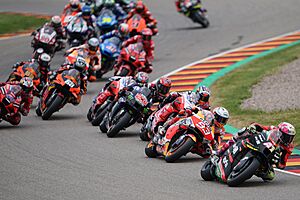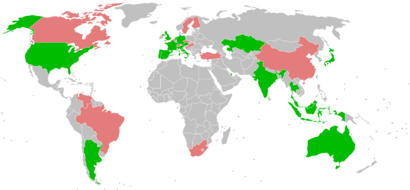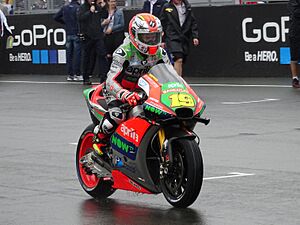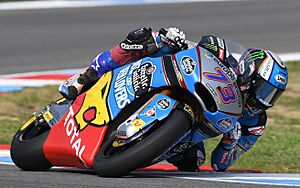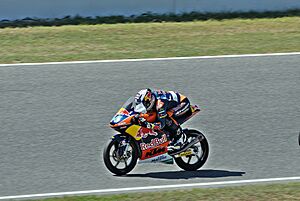Grand Prix motorcycle racing facts for kids
| MotoGP World Championship | |
|---|---|
| Category | Motorcycle racing |
| Region | International |
| Inaugural season | 2002 (originally in 1949 as 500cc) |
| Constructors | Aprilia, Ducati, Honda, KTM, Yamaha |
| Tyre suppliers | Michelin |
| Riders' champion | Jorge Martín |
| Constructors' champion | Ducati |
| Teams' champion | Ducati Lenovo Team |
| Moto2 World Championship | |
| Category | Motorcycle racing |
| Region | International |
| Inaugural season | 2010 (originally in 1949 as 250cc) |
| Constructors | Boscoscuro, Forward, Kalex |
| Tyre suppliers | Pirelli |
| Riders' champion | Ai Ogura |
| Constructors' champion | Kalex |
| Teams' champion | MT Helmets – MSi |
| Moto3 World Championship | |
| Category | Motorcycle racing |
| Region | International |
| Inaugural season | 2012 (originally in 1949 as 125cc) |
| Constructors | CFMoto, Gas Gas, Honda, Husqvarna, KTM |
| Tyre suppliers | Pirelli |
| Riders' champion | David Alonso |
| Constructors' champion | CFMoto |
| Teams' champion | CFMoto Aspar Racing Team |
| MotoE World Championship | |
| Category | Motorcycle racing |
| Region | Europe |
| Inaugural season | 2023 (originally in 2019 as World Cup) |
| Constructors | Ducati |
| Tyre suppliers | Michelin |
| Riders' champion | Héctor Garzó |
| Teams' champion | Dynavolt Intact GP MotoE |
Grand Prix motorcycle racing is the top level of motorcycle road racing. These exciting races happen on special road circuits and are approved by the Fédération Internationale de Motocyclisme (FIM). People have been racing motorcycles since the early 1900s. Big national races were often called "Grand Prix."
In 1949, the FIM was created to set rules for motorcycle sports. This allowed certain races to become official World Championships. Grand Prix motorcycle racing is actually the oldest motorsport world championship still running!
Grand Prix motorcycles are special racing machines. You can't buy them, and you can't ride them on regular public roads. This is different from other races, like the Superbike World Championship, where bikes are modified versions of motorcycles you can buy. Since 2002, the top racing class has been called MotoGP. Before that, it was known as the 500cc class. All the different classes are part of the official World Championship.
The championship has four main classes: MotoGP, Moto2, Moto3, and MotoE. The first three use four-stroke engines. The MotoE class uses cool electric motorcycles!
The most successful rider in Grand Prix history is Giacomo Agostini. He won 15 titles and 122 races! In the top class, Agostini has eight titles. Valentino Rossi has seven, and Marc Márquez, who is still racing, has six. As of 2023, Rossi holds the record for most wins in the top class with 89 victories.
Contents
History of Grand Prix Racing
The FIM first organized the Road Racing World Championship Grand Prix in 1949. Today, a company called Dorna Sports owns the commercial rights to the races. The FIM still sets the rules for the sport. Teams are represented by the International Road Racing Teams Association (IRTA). Manufacturers, who build the bikes, are represented by the Motorcycle Sport Manufacturers Association (MSMA). These four groups work together to decide on rules and changes.
In the past, there were many different race classes based on engine size. These included 50cc, 80cc, 125cc, 250cc, 350cc, 500cc, and 750cc bikes. There were also races for sidecars.
Up until the 1960s, four-stroke engines were the main type used. But then, two-stroke engines became more popular in smaller classes because of new designs.
In 1969, the FIM changed the rules to limit engines to six gears and fewer cylinders. This was to help reduce costs for smaller teams. Big manufacturers like Honda, Suzuki, and Yamaha left the sport for a while because of these changes. MV Agusta was one of the few factory teams left. Later, Yamaha (1973) and Suzuki (1974) came back with new two-stroke designs. Soon, two-strokes were used in all classes.
In 1979, Honda tried to bring back four-stroke engines to the top class with their NR500 bike, but it didn't work out. By 1983, even Honda was winning with two-stroke 500cc bikes.
Some classes have changed over time:
- The 50cc class ran from 1962 to 1983, then became an 80cc class from 1984 to 1989.
- The 350cc class ran from 1949 to 1982.
- The 750cc class ran from 1977 to 1979.
- Sidecars stopped being part of the World Championship in the 1990s.
From the mid-1970s to 2001, the top class allowed 500cc engines. Most bikes used two-stroke engines because they produced more power for their size.
In 2002, big rule changes came in to slowly remove the 500cc two-stroke bikes. The top class was renamed MotoGP. Manufacturers could now choose between 500cc two-stroke engines or 990cc four-stroke engines. The new four-stroke engines were more expensive, but they quickly became much more powerful. By 2003, no two-stroke bikes were left in the MotoGP class. The 125cc and 250cc classes still used two-stroke engines.
In 2007, the MotoGP engine size was reduced to 800cc for at least five years. To save money during the Great Recession in 2009, MotoGP made more changes. They cut down on practice and testing, made engines last longer, and started using only one tyre manufacturer. They also banned special qualifying tyres and other advanced systems.
For the 2012 season, the MotoGP engine size went back up to 1,000cc. They also introduced "Claiming Rule Teams" (CRTs). These teams got more engines and fuel, but factory teams could "claim" their engines for a set price. In 2014, CRTs became "Open" class teams, and the claiming rule was removed. By 2016, the "Open" class was gone, and all teams used a standard engine control unit.
In 2010, the 250cc two-stroke class was replaced by the new Moto2 class. These bikes used 600cc four-stroke engines. In 2012, the 125cc two-stroke class was replaced by the Moto3 class. These bikes use 250cc four-stroke engines and have a weight limit. For the 2019 season, Moto2 bikes started using 765cc Triumph engines, while Moto3 and MotoGP still use special prototype engines.
Key Moments in History
Pre-MotoGP Era
- 1949: The first world championship races begin for 125cc, 250cc, 350cc, 500cc, and sidecar classes.
- 1957: Big manufacturers like Gilera, Mondial, and Moto Guzzi leave due to high costs.
- 1961: The first world championship race outside Europe happens in Argentina.
- 1966: Honda wins championships in all five solo classes.
- 1969: New rules limit cylinders and gears, causing some manufacturers to leave.
- 1971: The first 500cc win for a two-stroke bike happens.
- 1972: Giacomo Agostini wins his seventh straight 500cc title.
- 1976: The Isle of Man TT race is removed from the Grand Prix calendar due to safety concerns.
- 1978: Kenny Roberts becomes the first American to win the 500cc class.
- 1982: The 350cc class ends.
- 1984: The 50cc class is replaced by the 80cc class.
- 1985: Freddie Spencer wins both the 250cc and 500cc titles in the same year.
- 1987: Push starts are no longer allowed.
- 1989: The 80cc class ends.
- 1993: A bike breaks the 200 mph (320 km/h) barrier for the first time.
- 1998: The 500cc class switches to unleaded fuel. Mick Doohan wins his fifth straight 500cc title.
- 2001: Valentino Rossi wins his first top-class title, becoming the last two-stroke champion.
MotoGP Era
2000s
- 2002: MotoGP replaces the 500cc class. Four-stroke 990cc bikes are introduced.
- 2003: No two-stroke bikes are left in MotoGP.
- 2007: MotoGP engine size is reduced to 800cc. Ducati wins the riders' and constructors' championships.
- 2009: Bridgestone becomes the only tyre supplier. Valentino Rossi wins his seventh and last MotoGP title.
2010s
- 2010: Moto2 replaces the 250cc class. All Moto2 engines are supplied by Honda.
- 2011: Suzuki stops participating in MotoGP.
- 2012: Moto3 replaces the 125cc class. MotoGP engine size increases to 1,000cc.
- 2013: Marc Márquez becomes the youngest ever top-class world champion.
- 2015: Suzuki returns to MotoGP. Jorge Lorenzo wins a close title fight against Valentino Rossi.
- 2016: Michelin returns as the tyre supplier.
- 2017: KTM joins the top class.
- 2019: Triumph replaces Honda as the Moto2 engine supplier. The MotoE class for electric motorcycles is introduced. A new "Long Lap" penalty is added. Marc Márquez wins his sixth MotoGP title. Valentino Rossi becomes the first rider to race in 400 Grand Prix events.
2020s
- 2020: The season is affected by the COVID-19 pandemic. Joan Mir wins the championship for Suzuki.
- 2021: Valentino Rossi retires. Fabio Quartararo becomes the first French rider to win a premier class championship.
- 2022: Suzuki stops participating in MotoGP again. Francesco Bagnaia wins the championship for Ducati.
- 2023: Sprint races are introduced at all Grand Prix events in the MotoGP class. MotoE becomes a World Championship. Brad Binder sets a new top speed record of 366.1 km/h (227.5 mph).
- 2024: Pirelli becomes the official tyre supplier for Moto2 and Moto3. Liberty Media, who owns Formula One, buys MotoGP. Jorge Martín becomes the first independent team rider to win the MotoGP World Championship.
How a Race Weekend Works
The starting grid for a race usually has about 20 riders, lined up in three columns. The fastest rider from qualifying starts in the first position, called the pole. Races last about 45 minutes. They are like a sprint from start to finish, with no stops for fuel or tyres.
Since 2005, MotoGP has a "flag-to-flag" rule. If it starts raining during a dry race, a white flag is shown. This means riders can go into the pit lane to switch to a different motorcycle. This second bike will have special "wet" tyres. The wet-weather bikes also use steel brake rotors instead of carbon ones, because carbon brakes need to be very hot to work well, and rain cools them down too much. The suspension is also made softer for wet conditions.
If a rider crashes, marshals wave yellow flags to warn others not to overtake in that area. If a fallen rider can't be safely moved, the race is stopped with a red flag. There are two main types of crashes:
- Lowside: The bike loses grip and slides out on its side.
- Highside: The tyres briefly lose grip, then suddenly grip again, flipping the bike over and often throwing the rider high into the air. Modern traction control has made highsides much less common.
In 2023, "Sprint" races were added. These shorter races happen on Saturday, and the main Grand Prix race is on Sunday. Sprint races are about half the length of a Grand Prix and riders score about half the points.
| Position | 1 | 2 | 3 | 4 | 5 | 6 | 7 | 8 | 9 | 10 | 11 | 12 | 13 | 14 | 15 |
|---|---|---|---|---|---|---|---|---|---|---|---|---|---|---|---|
| Points | 25 | 20 | 16 | 13 | 11 | 10 | 9 | 8 | 7 | 6 | 5 | 4 | 3 | 2 | 1 |
| Position | 1 | 2 | 3 | 4 | 5 | 6 | 7 | 8 | 9 |
|---|---|---|---|---|---|---|---|---|---|
| Points | 12 | 9 | 7 | 6 | 5 | 4 | 3 | 2 | 1 |
Riders
Current Riders
Here are some of the riders currently competing in MotoGP:
| Name | Country | Constructor | Team | No. |
|---|---|---|---|---|
| Johann Zarco | Honda | Castrol Honda LCR | 5 | |
| Luca Marini | Honda | Honda Racing | 10 | |
| Maverick Viñales | KTM | Red Bull KTM Tech3 | 12 | |
| Fabio Quartararo | Yamaha | Monster Energy Yamaha MotoGP Team | 20 | |
| Franco Morbidelli | Ducati | Pertamina Enduro VR46 Racing Team | 21 | |
| Enea Bastianini | KTM | Red Bull KTM Tech3 | 23 | |
| Raúl Fernández | Aprilia | Trackhouse Racing | 25 | |
| Pedro Acosta | KTM | Red Bull KTM Factory Racing | 31 | |
| Brad Binder | KTM | Red Bull KTM Factory Racing | 33 | |
| Joan Mir | Honda | Honda Racing | 36 | |
| Álex Rins | Yamaha | Monster Energy Yamaha MotoGP Team | 42 | |
| Jack Miller | Yamaha | Prima Pramac Racing | 43 | |
| Fabio Di Giannantonio | Ducati | Pertamina Enduro VR46 Racing Team | 49 | |
| Francesco Bagnaia | Ducati | Ducati Lenovo Team | 63 | |
| Marco Bezzecchi | Aprilia | Aprilia Racing | 72 | |
| Álex Márquez | Ducati | Gresini Racing MotoGP | 73 | |
| Miguel Oliveira | Yamaha | Prima Pramac Racing | 88 | |
| Jorge Martín | Aprilia | Aprilia Racing | 89 | |
| Marc Márquez | Ducati | Ducati Lenovo Team | 93 | |
| Fermín Aldeguer | Ducati | Gresini Racing MotoGP | TBA | |
| Somkiat Chantra | Honda | Idemitsu Honda LCR | TBA | |
| Ai Ogura | Aprilia | Trackhouse Racing | TBA |
Champions
The Riders' World Championship is given to the rider who earns the most points over a season. Points are awarded based on how well riders finish in each Grand Prix race.
Giacomo Agostini is the most successful champion ever, with 15 titles (8 in the 500cc class and 7 in the 350cc class). Mike Hailwood was incredibly dominant in 1966, winning 10 out of 12 races in the 250cc class. Mick Doohan also had an amazing year in 1997, winning 12 out of 15 races in the 500cc class.
Valentino Rossi is a very famous modern rider. He has won nine titles in total, including seven 500cc/MotoGP titles (from 2001–2005 and 2008–2009). He also won one title each in the 250cc and 125cc classes. The current champion is Spanish rider Jorge Martín.
Race Circuits
The 2025 MotoGP World Championship will visit 22 different circuits around the world:
 Thailand, Buriram, Chang International Circuit
Thailand, Buriram, Chang International Circuit Argentina, Termas de Río Hondo, Autódromo Termas de Río Hondo
Argentina, Termas de Río Hondo, Autódromo Termas de Río Hondo United States, Austin, Circuit of the Americas
United States, Austin, Circuit of the Americas Qatar, Lusail, Lusail International Circuit
Qatar, Lusail, Lusail International Circuit Spain, Jerez de la Frontera, Circuito de Jerez – Ángel Nieto
Spain, Jerez de la Frontera, Circuito de Jerez – Ángel Nieto France, Le Mans, Bugatti Circuit
France, Le Mans, Bugatti Circuit United Kingdom, Silverstone, Silverstone Circuit
United Kingdom, Silverstone, Silverstone Circuit Spain, Alcañiz, MotorLand Aragón
Spain, Alcañiz, MotorLand Aragón Italy, Scarperia e San Piero, Autodromo Internazionale del Mugello
Italy, Scarperia e San Piero, Autodromo Internazionale del Mugello Netherlands, Assen, TT Circuit Assen
Netherlands, Assen, TT Circuit Assen Germany, Hohenstein-Ernstthal, Sachsenring
Germany, Hohenstein-Ernstthal, Sachsenring Czech Republic, Brno Circuit, Brno
Czech Republic, Brno Circuit, Brno Austria, Spielberg, Red Bull Ring
Austria, Spielberg, Red Bull Ring Hungary, Balaton Park Circuit, Balatonfőkajár
Hungary, Balaton Park Circuit, Balatonfőkajár Spain, Montmeló, Circuit de Barcelona-Catalunya
Spain, Montmeló, Circuit de Barcelona-Catalunya Italy, Misano Adriatico, Misano World Circuit Marco Simoncelli
Italy, Misano Adriatico, Misano World Circuit Marco Simoncelli Japan, Motegi, Mobility Resort Motegi
Japan, Motegi, Mobility Resort Motegi Indonesia, Central Lombok, Pertamina Mandalika International Street Circuit
Indonesia, Central Lombok, Pertamina Mandalika International Street Circuit Australia, Phillip Island, Phillip Island Grand Prix Circuit
Australia, Phillip Island, Phillip Island Grand Prix Circuit Malaysia, Sepang, Petronas Sepang International Circuit
Malaysia, Sepang, Petronas Sepang International Circuit Portugal, Portimão, Algarve International Circuit
Portugal, Portimão, Algarve International Circuit Spain, Valencia, Circuit Ricardo Tormo
Spain, Valencia, Circuit Ricardo Tormo
Technical Rules for Bikes
Here are some of the main technical rules for each class. In 2005, a rule was added to stop teams from cooling their fuel too much. This is because cooler fuel is denser and could give a small power boost.
MotoGP class

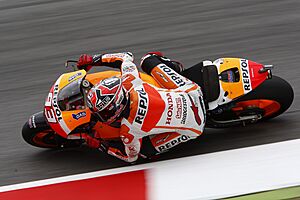

When the new MotoGP era began in 2002, bikes could have 500cc two-stroke or 990cc four-stroke engines. The four-stroke engines were so much more powerful that by the next season, all teams were using them. In 2007, the maximum engine size was reduced to 800cc.
MotoGP bikes can have different engine setups. However, the more cylinders an engine has, the heavier the motorcycle must be. This is a way to balance the competition. Engines with more cylinders can usually make more power for the same size. Today, most teams use four-cylinder engines because they offer a good balance of weight, power, and fuel use.
In 2002, the FIM worried about bikes getting too fast. So, they changed rules about weight, fuel, and engine size. They reduced engine size from 990cc to 800cc and limited fuel from 26 litres (6.9 US gal) in 2004 to 21 litres (5.5 US gal) from 2007 onwards. The minimum weight for four-cylinder bikes also increased.
The fastest speed ever recorded for a MotoGP bike was 366.1 km/h (227.5 mph). This was set by Brad Binder in 2023 at the Italian Grand Prix.
On December 11, 2009, it was announced that MotoGP would switch back to 1,000cc engines starting in the 2012 season. Engines were limited to four cylinders and a maximum bore of 81 mm (3.2 in).
From 2012, smaller teams could get "claiming rule team" (CRT) status. This helped independent teams compete at a lower cost. CRTs got more engines and more fuel. Later, the CRT class was replaced by an "Open Class" in 2014. These teams used a standard electronic control unit (ECU) and got some benefits to help them be more competitive.
In 2023, "ride height devices" were banned. These devices allowed bikes to be lowered for better acceleration at the start of a race.
Moto2 class
Moto2 started in 2010. It replaced the 250cc two-stroke class. Initially, all Moto2 bikes used 600cc four-stroke engines supplied by Honda. Tyres were supplied by Dunlop. Carbon brake discs are not allowed; only steel brake discs can be used.
In 2019, Triumph became the new engine supplier for Moto2. Their engines are 765cc with three cylinders. In 2024, Pirelli took over from Dunlop as the sole tyre supplier for both Moto2 and Moto3.
Moto3 class
The 125cc class was replaced by the Moto3 class in 2012. Moto3 bikes use single-cylinder 250cc four-stroke engines. The maximum bore (the width of the cylinder) is 81 mm (3.2 in). The bike and rider together must weigh at least 148 kg (326 lb).
In the past, riders had to be between 16 and 28 years old. However, after some serious accidents involving young riders, the FIM set a new minimum age of 18 starting in the 2023 season.
MotoE class
The MotoE World Cup began in 2019. This class features all-electric motorcycles. The bikes used are called Energica Ego Corsa, made by Energica Motor Company. The first season had 6 races over 4 Grand Prix weekends.
In 2023, the MotoE class became a full World Championship. At the same time, they switched to using Ducati electric bikes.
Engine and Power Details
| Specification | MotoGP | Moto2 | Moto3 | MotoE |
|---|---|---|---|---|
| Manufacturer | Various | Honda (2010–2018) Triumph (from 2019) |
Various | Ducati |
| Engine Type | V-4 or Inline-four | Inline-four (2010–2018) Inline-three (from 2019) |
Single-cylinder | Electric motor |
| Engine Size | 1,000 cc (61 cu in) | 600 cc (37 cu in) (2010–2018) 765 cc (47 cu in) (from 2019) |
250 cc (15 cu in) | n/a |
| Engine Cycle | Four-stroke (since 2012) | |||
| Fuel | Unleaded gasoline | Unleaded gasoline | ||
| Power | Over 290 bhp | 120-150 bhp (2010–2018) Over 140 bhp (from 2019) |
Under 55 bhp | 147-161 bhp (110-120 kW) |
| Torque | Over 120 Nm | 55-70 Nm (2010–2018) 80 Nm (from 2019) |
28 Nm | Over 220 Nm |
| Max Speed | 366.1 km/h (227.5 mph) | 308.5 km/h (191.7 mph) | 255.9 km/h (159.0 mph) | 260-270 km/h (160-170 mph) |
Bike Weights
The minimum weight for MotoGP bikes depends on the number of cylinders. This helps to balance the competition.
- In 2005, fuel tank size was reduced from 24 litres (6.3 US gal) to 22 litres (5.8 US gal).
- From 2007, two-stroke bikes were no longer allowed in MotoGP. Fuel capacity was set at 21 litres (5.5 US gal).
- In 2012, engine size increased to 1000cc.
- For 2013, the minimum weight for MotoGP bikes increased to 160 kg (350 lb).
- In 2014, fuel tank capacity was 20 litres (5.3 US gal) for factory teams and 24 litres (6.3 US gal) for Open Entries.
- For 2015, minimum weight was lowered to 158 kg (348 lb).
- In 2016, all bikes had a fuel tank capacity of 22 litres (5.8 US gal).
Tyres
Choosing the right tyres is very important for riders. They decide based on how the bike feels during practice and warm-up, and what the weather forecast is. Riders have to balance grip (how well the tyre sticks to the track) and how long the tyre will last. Softer tyres have more grip but wear out faster. Harder tyres last longer but have less grip. Being able to save your tyres during a race is a key skill for winning.
Before 2009, teams used special "qualifying" tyres that were super soft for maximum grip, but only lasted a lap or two. These were banned to save costs. In wet conditions, bikes use special "wet" tyres with deep treads. If the track dries out, these tyres wear out very quickly.
Since 2009, only one tyre supplier has been used for MotoGP. This helps to keep the competition fair. For the 2009, 2010, and 2011 seasons, Bridgestone was the sole supplier. They provided different types of tyres for front and rear, but no special qualifying tyres. Tyres are given to riders randomly to ensure fairness.
At the end of 2015, Bridgestone stopped supplying tyres to MotoGP. After a selection process, French tyre maker Michelin became the official supplier again for the 2016 season.
See also
 In Spanish: Campeonato Mundial de Motociclismo para niños
In Spanish: Campeonato Mundial de Motociclismo para niños
- MotoGP Rookie of the Year
- Outline of motorcycles and motorcycling
- Grand Prix motorcycle racing sponsorship liveries
- List of Grand Prix motorcycle races
- List of 500cc/MotoGP World Riders' Champions


